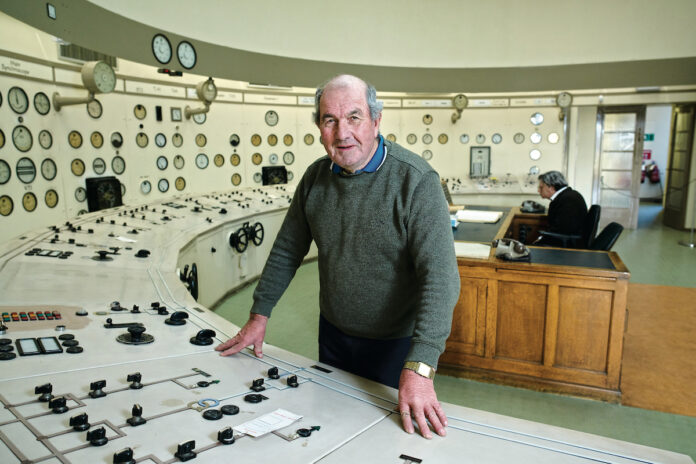CONTROLLING the water levels on the River Shannon and the Head Race Canal continues to be a key aspect of Ardnacrusha Power Station, according to an experienced retired electrician.
Looking back on his 44-year stint in Ardnacrusha, Francis Moloney (73) from Clonlara has outlined other statutory obligations staff fulfilled, apart from vital electricity generation.
In the winter time, he recalled during high water levels Ardnacrusha was responsible for maintaining certain levels on the River Shannon.
“People working up along the Shannon in places like Killaloe and Portumna would report what the water levels were to staff in Ardnacrusha where they are logged to determine the input into the River Shannon, which dictates what generation is going to be done at a particular time.
“If the levels in the River Shannon go above the statutory level, you commence spilling of excess water down the Old River Shannon where people like Bertie Poole would operate the gates at Parteen Weir on behalf of the station. The station are managing the water levels on behalf of the OPW.
“Once the level in Killaloe reaches 33.56 metres any excess water has to be spilled. If the water keeps building up in Killaloe, it will build up in Portumna and Athlone. A balance has to be struck.”
It is hoped the new Springfield Flood Protection Embankment will protect a lot of the low-lying land in the area.
“On a flood load Ardnacrusha would normally take about 400 cubic metres of water when the four machines are operating. In some of the most recent floods there was more than 900 cubic metres of water coming in so you have to get rid of the excess.
“Nowadays the Civil Works Department have the hydrometric expertise to manage and spill the excess water.
“Previously, there was a dedicated hydrometric engineer. It is a delicate operation, but it is well monitored. No person can go off on a blind run. It is very strictly controlled.
“When the gates are opened at Parteen Weir the gate controller would get the information from the hydrometric engineer. All the movements and times of the gates are all logged as part of a statutory record,” he said.
Mr Moloney also pointed out the water levels in the Head Race are also strictly controlled and its statutory limit is 31 metres 50.
If the water drops below 31 metres 25, this could result in air being sucked into the penstock in the station, which could burst them.
The penstock brings the water down from the intake gate to the machine through large pipes.
The Clonlara native went from being a maintenance electrician repairing the plant to helping operate the station.
He recalled there was a time when Ardnacrusha operated the networks operation particularly for the local transmission lines.
During storms when ESB lines are damaged, he said operations staff were very busy in the station changing the lines and changing the configuration of the transmission system to facilitate repair work on the network.
All areas in the station were allocated for certain types of ESB workers. The mechanical worker and electricians operated in different but distinct parts of the station as part of clear demarcation.
“Everyone was very friendly with one another. However, the electrician wouldn’t be left down to the mechanical workshop or the fitter wouldn’t come up to the electrical workshop. Everything has changed in the ESB.
“Now an employee is called a technician and multi-tasking is the buzz word. Casual workers used to be taken on for a few months and some of them were well matured.
“Paddy Spain was the supervisor of the day workers, his grandson is Karl Spain, the well known comedian. We used to go down to their place for tea which was nicknamed the “dark hole of Calcutta’ because it was pitch dark in places when you would go in to this cable cellar.
“The men loved duck eggs and thick sandwiches with plenty of butter,” he said.
Having attended Clonlara National School, Mr Moloney went to the Municipal and Technical School in Limerick, commonly known as the Tech.
In 1966, he joined the ESB as an apprentice technician, a week before his work colleague Sean Creamer from Portroe. He was part of the group that completed their Block Release in the School of Electrical Engineering in O’Connell Avenue, Limerick.
In 1971, he was fully qualified as an electrician working as a casual with the ESB before he was made permanent as part of the maintenance staff in 1973.
As part of his relief shift work, he learned the operations part of the power station over a number of years. In 1980, he was appointed to the operations staff where he remained until his retirement in 2010.
This involved looking after the starting and stopping of machines and synchronising with the whole system. In addition, he looked after the water levels in the River Shannon.
There was a four-man operations team – a supervisor, controller operator, machine floor attendant and turbine attendant on a three-cycle shift, evenings, days and nights.
The team managed the station from an operations perspective.
He worked in the Control Room – one of the key parts of the station. The four generators on the machine floor loaded and unloaded from the Control Room.
The generators produce electricity at 10,000 volts. This was transformed straight away to 40,000 or 110,000 for transmission purposes.
Different colours on the semi-circular desk panels indicated the transmission lines or bus bars, lines carrying 10,000 volts were shown in blue, the 40,000 volt bar was shown in yellow and the 110,000 volt bar was depicted in red.
All generation from the station was fed into a common network or grid, which links the whole country.
The 110,000 volt lines feed bulk load to major centres while the voltage is reduced to 40,000 for a more local network. Transformers in these smaller areas in turn reduce the voltage to 400 volts for power purposes and 220 volts for domestic distribution.
Some local areas can be fed direct from Ardnacrusha at 40,000 volts.
Throughout its history, considerable modernisation has taken place in the Control Room, but there still remains some of the original equipment installed by Siemens Schuckert.
At the behest of the LDO and later the National Control Centre, the operations staff were involved in electricity distribution. There are 13 40 kv lines and four 110 kv lines.
When Ardnacrusha was first commissioned it was supplying about 95% of the country’s electricity needs. This dropped to about 2% today as the network demand dramatically increased and other power stations started contributing to the national grid.
At a full load and a high lake, Ardnacrusha could produce up to 110 mega watts but it is generally less than this.
In 1995, there was a major refurbishment of the station. This sparked a major change from a manned operation to a remote controlled station. This sparked the death knell of the operations three rota shift in the station.
“We went to a one-man operation for a while. It is still only a one-man operation but is normally only a day operation. In an emergency, staff can be rostered to go on duty evenings and nights, but this hasn’t happened even during the recent big flood the station wasn’t manned. The station is now managed remotely from Turlough Hill.
“This is a big loss for Ardnacrusha. In the early days there were 18 full jobs on shift, plus relief jobs. The electricians covered the relief for the control room. When people retired from the control room, the relief staff generally had a good chance of getting these jobs. They were not guaranteed because it was an open competition.”
To go from no load to a full load in the station takes about three hours.
The station could be producing 40 mega watts up to 12 noon and this would then be increased to 60 of 80 mega watts for the peak hours.
“If you have plenty of water, the four turbines can operate. If the lake is high, the water will come down. The last thing the ESB wants to do is to spill water because that is money down the drain.
“There is no water spilling down the Old River Shannon until the four machines are on a full load. It is the excess water that is spilled down the Shannon.
“If one of the machines is off load for maintenance, there is a facility in the station to open the spill way gate, which takes the equivalent of a machine. That is part of the regulation and that will go down the Old River Shannon.
“The machines in the station operate at 150 revs per minute. There is a safety mechanism built in if the machines go into over speed, the mechanical over speed mechanism would drop the gate to prevent the water coming in so the machine couldn’t run.
“The machine floor operator is in charge of bringing the machines up to 150 revs and once he is happy, he hands it over to the Control Room Operator, who will synchronise the machine with the system. He will then load the machine after getting a request from the National Control Centre of how many mega watts are to be loaded.
“Normally, they spread the load over the four machines because they like to have a bit of spare capacity in case there is a glitch on the system and a few extra mega watts are needed quickly,” he explained.
He outlined it is important to keep the frequency at 50 cycles per second. In its early days, Ardnacrusha had control of the frequency. The frequency is now controlled by the National Control Centre.
East Clare correspondent, Dan Danaher is a journalism graduate of Rathmines and UL. He has won numerous awards for special investigations on health, justice, environment, and reports on news, agriculture, disability, mental health and community.



